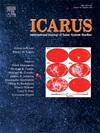Spectral feature variations of low-iron olivine under intense pulse-laser irradiations
IF 3
2区 物理与天体物理
Q2 ASTRONOMY & ASTROPHYSICS
引用次数: 0
Abstract
Space weathering processes, including micrometeoroid impact and solar wind irradiation typically redden, darken, and attenuate the fingerprint absorption features in the visible and near-infrared (VNIR) reflectance spectra of planetary surface materials. The so-called lunar style space weathering typically produces nanophase metallic iron (npFe0) and amorphous mineral layers. This paradigm has been known to be inadequate in describing the weathering processes on many other airless bodies and many open questions are waiting to be answered. For example, the greater flux of micrometeorite impacts or higher surface temperature on Mercury may produce larger npFe0 particles; the gardening effects on space weathering remain largely unknown; on asteroids such as Vesta, random regolith mixing and contamination by exogenic material from impacts are believed to be the dominant space weathering processes. To understand these and other questions in non-lunar style space weathering, we conducted pulsed laser irradiations on low-iron olivine grains in powders and pellets at various energy levels. By performing transmission electron microscope and reflectance spectroscopic measurements, we found that progressive irradiation caused continuous darkening. Meanwhile, the VNIR spectral slope changed from reddening to bluing after reaching a “saturation point”, and the absorption band depth transitioned from weakening to stabilization. At the same time, repeated irradiations led to limited growth of npFe0 particles in low-iron olivine. In all simulated irradiations, significant spectral alterations occurred in early stages, implying that fresh surfaces are more sensitive to space weathering. The rates of spectral modification of powder samples were found to be remarkably lower than those of the pellet samples. We also observed that exogenous metal contaminants could evaporate and condense into an opaque layer during simulated bombardments, obscuring the original spectral features of regolith.
强脉冲激光照射下低铁橄榄石的光谱特征变化
空间风化过程,包括微流星体撞击和太阳风辐射,通常会使行星表面物质的可见和近红外(VNIR)反射光谱中的指纹吸收特征变红、变暗和衰减。所谓的月球式太空风化通常会产生纳米相金属铁(npFe0)和无定形矿物层。这种模式在描述许多其他无空气物体的风化过程中已经被认为是不够的,许多悬而未决的问题正在等待回答。例如,微陨石撞击通量越大或水星表面温度越高,可能产生较大的npFe0颗粒;园艺对太空风化的影响在很大程度上仍然未知;在像灶神星这样的小行星上,随机的风化层混合和来自撞击的外源物质的污染被认为是主要的空间风化过程。为了了解这些和其他非月球风格的太空风化问题,我们对不同能量水平的粉末和颗粒中的低铁橄榄石颗粒进行了脉冲激光照射。通过透射电子显微镜和反射光谱测量,我们发现渐进式辐照引起连续变暗。同时,VNIR光谱斜率在达到“饱和点”后由变红变为变蓝,吸收带深度由减弱变为稳定。同时,重复辐照导致npFe0颗粒在低铁橄榄石中的生长受限。在所有的模拟辐射中,显著的光谱变化发生在早期阶段,这意味着新鲜的表面对空间风化更敏感。发现粉末样品的光谱修饰率明显低于颗粒样品。我们还观察到外源金属污染物可以在模拟轰击过程中蒸发并凝结成不透明层,从而模糊了风化层的原始光谱特征。
本文章由计算机程序翻译,如有差异,请以英文原文为准。
求助全文
约1分钟内获得全文
求助全文
来源期刊

Icarus
地学天文-天文与天体物理
CiteScore
6.30
自引率
18.80%
发文量
356
审稿时长
2-4 weeks
期刊介绍:
Icarus is devoted to the publication of original contributions in the field of Solar System studies. Manuscripts reporting the results of new research - observational, experimental, or theoretical - concerning the astronomy, geology, meteorology, physics, chemistry, biology, and other scientific aspects of our Solar System or extrasolar systems are welcome. The journal generally does not publish papers devoted exclusively to the Sun, the Earth, celestial mechanics, meteoritics, or astrophysics. Icarus does not publish papers that provide "improved" versions of Bode''s law, or other numerical relations, without a sound physical basis. Icarus does not publish meeting announcements or general notices. Reviews, historical papers, and manuscripts describing spacecraft instrumentation may be considered, but only with prior approval of the editor. An entire issue of the journal is occasionally devoted to a single subject, usually arising from a conference on the same topic. The language of publication is English. American or British usage is accepted, but not a mixture of these.
 求助内容:
求助内容: 应助结果提醒方式:
应助结果提醒方式:


